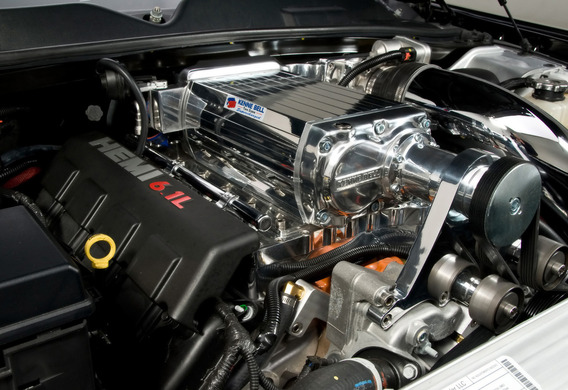
HEMI (HEMI) Motor is an internal combustion engine with a semi-spherical combustion chamber. The name of this powertrain comes from the English "hemispherical"-"semi-spherical". Appointment
Appointment
The original technology was used by Chrysler, and the manufacturer itself positioned it as a motor-port oriented: mostly HEMI V8 engines can be found on powerful sports cars. These engines are considered sporty because of their design. Thus, the location of the valves at an angle rather than in one plane makes it possible to increase the size of the valves themselves, which improves the ventilation of the combustion chamber and the output capacity is significantly increased. In addition, the intake capacity of the engine is increased: the fuel-air mixture has less curved lines due to the special construction, which reduces the flow resistance of the mixture.
HEMI Motor Construction
From a normal V8 engine, the HEMI powertrain is the first of its design: the top set of the cylinder combustion chamber is made in the form of a half-spherical cupola on which the spark plugs and two valves are located. The lower surface of the combustion chamber is formed by a piston with a flat surface. This is a fundamental difference from other engines in which the combustion chamber has a cylindrical form, with a flat surface of the upper body and piston.
It is worth noting that HEMI engines have a number of features that can be attributed to disadvantages. Among them is the more complex cylinder head structure due to the complex mechanism of the valve actuator, and some difficulties in achieving higher degrees of compression due to the increased height of the combustion chamber. Also, the power units are more demanding for fuel and the cost of their production is much higher. Besides, they're almost a quarter heavier than other engines, more toxic and voracious. But there are advantages beyond the above-listed HEMI engines, and the vibration level is markedly lower. Although it is worth noting that HMI engines, because of their handicaps, have not received mass distribution.

History
It is worth noting that Chrysler used the HMI engine for military jet fighters P-47 Thunderbolt: those motors had 16 cylinders, V-shaped and 2.5 thousand horsepower. Later, in the early 1950s, 8 cylinders with semi-spherical cameras appeared on Chrysler's sports cars and then on Plymouth. HEMI cars won many victories, including the Daytona 500, INDY 500 and NASCAR. In the latter, by the way, such engines had to be banned in 1965.
HEMI was actively used in the drag race: the engine was slightly modified, for example, using an aluminium double-flat four-chamber intake manifold. This collector was later manufactured from magnesium, and in order to reduce the mass of the motor, the head of the cylinders was made of aluminium. An interesting fact is that all the powertrains of HEMI have been valid for 1 year, toga as normal engines-5 years. Moreover, if the car took part in the drag race ("subject to extreme loads"), the guarantee was cancelled.
But HEMI engines were also installed in ordinary urban cars-the "road" version of the engine was called "Street HEMI." Street HEMI was made of iron and the engine had a lower compression ratio than the racing variants. The setting of HEMI was a pretty expensive option, with a price of $1,000. But the engine could work with both a manual gearbox and a machine gun.
During its lifetime, the HEMI engine has been modified and modified. For example, at the end of the 60 th, the powertrain was equipped with a slightly increased move, and some modification succeeded in reducing the oil consumption.
HMI engines were installed on vehicles such as Dodge Charger, Dodge Super Bee, Plymouth GTX, Plymouth Barracuda, Plymouth Roadrunner, as well as on the relatively modern Chrysler 300c HEMI V8, Jeep Grand Cherokee 5.7, Grand Cherokee SRT8 6.4 and Dodge Challenger.
Interesting facts from HMI's "biographies":
The first engines with spherical heads appeared more than 100 years ago.
The cost of the HEMI engine in the middle of the twentieth century was one third of the cost of the vehicle.
In 1991, the HMI car set an absolute speed record in the Supercharted class, accelerating to 659mph.









